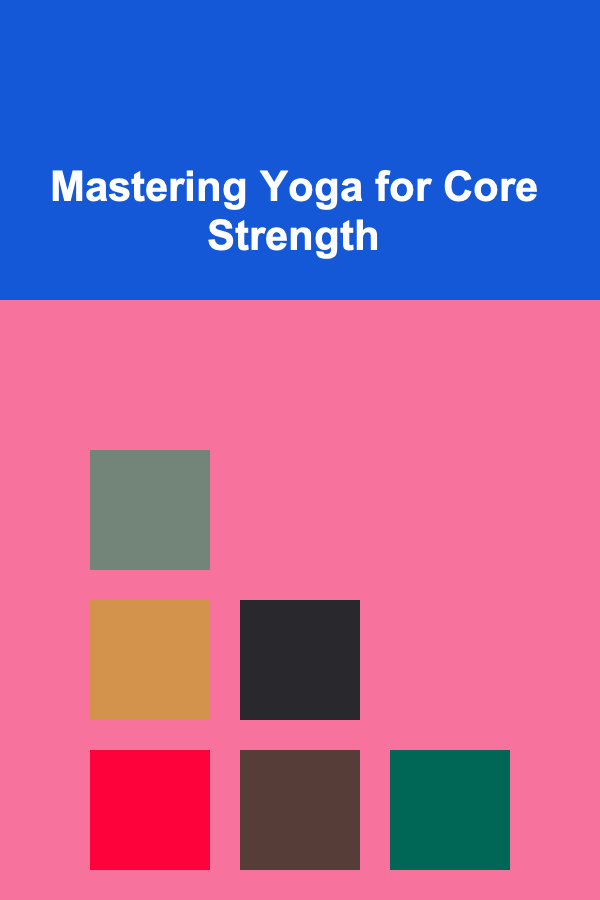
Mastering Yoga for Core Strength
ebook include PDF & Audio bundle (Micro Guide)
$12.99$5.99
Limited Time Offer! Order within the next:

Yoga, often perceived as a practice for flexibility and stress reduction, is also a potent tool for building core strength. However, simply attending a general yoga class may not be enough to unlock its full potential for abdominal and back muscle development. This article delves into how to strategically approach yoga to specifically target and strengthen your core, providing a comprehensive guide to poses, techniques, and principles for achieving a robust and functional midsection.
Understanding the Core: More Than Just Abs
Before diving into specific yoga practices, it's crucial to understand what the "core" truly encompasses. It's not merely the rectus abdominis, the "six-pack" muscle. The core is a complex network of muscles that stabilize the spine, pelvis, and hips. This intricate system includes:
- Rectus Abdominis: The superficial abdominal muscle responsible for spinal flexion (e.g., crunches).
- Obliques (Internal and External): These muscles facilitate rotation and lateral flexion of the spine.
- Transversus Abdominis (TVA): The deepest abdominal muscle, acting like a natural corset to support the spine and compress the abdomen. It's crucial for stability and protecting the lower back.
- Multifidus: Small muscles that run along the spine, providing stability and controlling intervertebral movement.
- Erector Spinae: A group of muscles running along the spine, responsible for spinal extension and maintaining posture.
- Quadratus Lumborum (QL): Located in the lower back, the QL helps with lateral flexion and stabilizes the pelvis.
- Diaphragm: The primary muscle of respiration, which also plays a role in core stability and intra-abdominal pressure.
- Pelvic Floor Muscles: These muscles support the pelvic organs and contribute to core stability.
Effective core work in yoga needs to engage all of these muscles, not just the superficial abs. This holistic approach builds functional strength that translates to improved posture, balance, reduced back pain, and enhanced athletic performance.
Principles of Core Engagement in Yoga
Merely going through the motions of yoga poses won't automatically strengthen your core. Conscious engagement and proper technique are paramount. Here are some key principles to keep in mind:
- Breath Awareness (Pranayama): Deep, conscious breathing is fundamental. Specifically, Ujjayi breath (victorious breath) and diaphragmatic breathing (belly breathing) are powerful tools. Inhaling expands the abdomen, while exhaling draws the navel towards the spine, engaging the TVA. Coordination of breath and movement is key.
- Mula Bandha (Root Lock): This energetic lock involves contracting the pelvic floor muscles, as if trying to stop urination mid-stream. It provides a stable base for the spine and draws energy upwards. Mula Bandha should be engaged subtly and sustained throughout the practice.
- Uddiyana Bandha (Abdominal Lock): This involves drawing the abdomen inward and upward, creating a hollow space beneath the ribs. It strengthens the TVA and supports the lower back. This bandha is typically practiced on an exhale. It's important to learn Uddiyana Bandha correctly from a qualified teacher to avoid strain. Note: Uddiyana Bandha is contraindicated for pregnant women and individuals with certain medical conditions.
- Spinal Alignment: Maintaining a neutral spine, neither excessively arched nor rounded, is crucial for safety and effectiveness. Imagine a straight line running from the crown of your head to your tailbone.
- Active Engagement vs. Passive Holding: Avoid simply collapsing into poses. Actively engage the muscles to support your body weight. For example, in Plank Pose, actively press the floor away, engage the glutes, and draw the navel towards the spine.
- Progressive Overload: Gradually increase the difficulty of poses and the duration of holds. This principle is essential for building strength and preventing plateaus.
- Mindful Awareness: Pay attention to your body's sensations. Notice which muscles are engaged and how your breath affects your stability. Avoid pushing yourself beyond your limits.
Yoga Poses for Core Strength: A Comprehensive Guide
The following poses, when practiced with proper technique and mindful engagement, can significantly enhance core strength. The poses are categorized by level of difficulty (Beginner, Intermediate, Advanced) to help you progress safely and effectively.
Beginner Level: Building a Foundation
- Cat-Cow Pose (Marjaryasana to Bitilasana): This gentle sequence warms up the spine and improves core awareness. On the inhale, arch the back (Cow Pose), and on the exhale, round the spine (Cat Pose). Focus on moving from the core, rather than simply moving the limbs.
- Table Top Pose (Bharmanasana): This foundational pose strengthens the wrists, arms, and core. Ensure your shoulders are directly over your wrists and your hips are directly over your knees. Engage the core to maintain a flat back and avoid sagging.
- Bird Dog Pose (Dandayamana Bharmanasana): This pose challenges balance and core stability. From Table Top, extend one arm forward and the opposite leg backward, keeping your core engaged to maintain a straight line from head to heel. Avoid arching the back.
- Plank Pose (Phalakasana): A classic core strengthener. Maintain a straight line from head to heels, engaging the core, glutes, and legs. Avoid sagging or hiking the hips. Hold for 20-30 seconds, gradually increasing the duration. A modified version can be done on the knees.
- Knee to Chest Pose (Apanasana): A gentle pose to release tension in the lower back and massage the abdominal organs. Lie on your back and draw your knees towards your chest. Gently rock from side to side.
- Supine Pelvic Tilts (Setu Bandhasana Variation): Lie on your back with knees bent and feet flat on the floor. Gently tilt your pelvis up, engaging your abdominal muscles and pressing your lower back into the floor. Hold for a few seconds and release.
Intermediate Level: Increasing the Challenge
- Side Plank (Vasisthasana): This pose strengthens the obliques and improves lateral stability. Start in Plank Pose, then rotate to one side, stacking your feet and lifting your top arm towards the ceiling. Engage your core to maintain a straight line from head to feet. A modified version can be done with the bottom knee on the floor.
- Boat Pose (Navasana): This pose strengthens the abdominal muscles and hip flexors. Sit with your knees bent and feet off the floor. Lean back slightly, engaging your core to maintain balance. Extend your arms forward, parallel to the floor. For a greater challenge, straighten your legs.
- Low Boat Pose (Ardha Navasana): A more challenging variation of Boat Pose. Lower your upper body and legs closer to the floor while maintaining core engagement. The lower you go, the more intense the core work.
- Reverse Plank (Purvottanasana): This pose strengthens the back of the body, including the glutes, hamstrings, and back extensors. Start seated with legs extended in front of you. Place your hands slightly behind you, fingers pointing forward. Press into your hands and feet to lift your hips towards the ceiling, creating a straight line from shoulders to ankles.
- Warrior III (Virabhadrasana III): This balancing pose requires significant core strength to maintain stability and alignment. From Warrior I or II, shift your weight onto one leg and hinge forward, lifting the other leg behind you until your body is parallel to the floor. Engage your core to keep your spine straight and avoid arching the back.
- Forearm Plank (Makara Adho Mukha Svanasana): A variation of Plank Pose that places less stress on the wrists. Maintain a straight line from head to heels, engaging the core, glutes, and legs. Distribute your weight evenly between your forearms.
- Revolved Triangle Pose (Parivrtta Trikonasana): A twisting pose that strengthens the core, legs, and ankles. Start in Triangle Pose, then twist your torso towards your front leg, bringing your opposite hand to the floor or a block. Keep your spine long and engaged.
Advanced Level: Maximizing Core Power
- Handstand (Adho Mukha Vrksasana): This advanced inversion requires significant core strength, balance, and coordination. Practice with a wall for support until you feel confident. Engage your core to maintain a straight line from head to heels.
- Crow Pose (Bakasana): This arm balance requires strong core muscles to stabilize the body. Squat down and place your hands shoulder-width apart on the floor. Lean forward, placing your knees high on your upper arms. Engage your core and lift your feet off the floor.
- Eight-Angle Pose (Astavakrasana): This challenging arm balance requires significant strength, flexibility, and coordination. It involves twisting the legs and torso while balancing on the arms.
- Pike Plank (Uttihita Chaturanga Dandasana Variation): Start in Plank Pose. Engaging your core, lift your hips up and back, creating an inverted V shape with your body. This pose requires significant abdominal strength and control.
- Hollow Body Hold: Lie on your back with your arms extended overhead and your legs extended forward. Engage your core to lift your shoulders and legs off the floor, maintaining a slight curve in your lower back. This exercise intensely engages the rectus abdominis and TVA.
- Yoga Wheel Core Work: Incorporating a yoga wheel into your practice can challenge your core in new ways. Experiment with poses like plank with the feet on the wheel, backbends over the wheel, and core roll-outs.
Sample Yoga Sequences for Core Strength
Here are a couple of sample yoga sequences designed to target core strength. Remember to warm up before starting and cool down afterward. Adjust the duration of holds and the number of repetitions to suit your fitness level.
Sequence 1: Beginner Core Awakening
- Cat-Cow Pose (5-10 repetitions)
- Table Top Pose (Hold for 30 seconds)
- Bird Dog Pose (5-10 repetitions per side)
- Plank Pose (Hold for 20-30 seconds, modified on knees if needed)
- Knee to Chest Pose (1 minute)
- Supine Pelvic Tilts (10-15 repetitions)
- Corpse Pose (Savasana) (5 minutes)
Sequence 2: Intermediate Core Strengthening
- Sun Salutations (A or B) (3-5 rounds)
- Plank Pose (Hold for 30-60 seconds)
- Side Plank (Hold for 30-60 seconds per side)
- Boat Pose (3-5 repetitions, holding for 30 seconds each time)
- Low Boat Pose (3-5 repetitions, holding for 20 seconds each time)
- Reverse Plank (Hold for 30-60 seconds)
- Warrior III (Hold for 30 seconds per side)
- Forearm Plank (Hold for 30-60 seconds)
- Revolved Triangle Pose (Hold for 30 seconds per side)
- Corpse Pose (Savasana) (5 minutes)
Beyond Poses: Lifestyle Factors for Core Strength
Yoga poses are a powerful tool for core strength, but a holistic approach also considers lifestyle factors that support or hinder progress. These include:
- Nutrition: A balanced diet rich in protein, complex carbohydrates, and healthy fats is essential for muscle growth and repair. Avoid processed foods, sugary drinks, and excessive alcohol consumption.
- Hydration: Staying adequately hydrated is crucial for muscle function and overall health.
- Sleep: Adequate sleep is essential for muscle recovery and growth. Aim for 7-9 hours of quality sleep per night.
- Stress Management: Chronic stress can lead to muscle tension and imbalances. Yoga, meditation, and other stress-reducing practices can help.
- Proper Posture: Maintaining good posture throughout the day is crucial for core engagement and spinal health. Be mindful of your posture while sitting, standing, and walking.
Common Mistakes to Avoid
To maximize the benefits of yoga for core strength and minimize the risk of injury, avoid these common mistakes:
- Holding Your Breath: Breath is crucial for core engagement and stability. Continuously breathe deeply and consciously throughout the practice.
- Arching Your Back: Excessive arching in poses like Plank Pose or Cobra Pose can strain the lower back. Engage your core to maintain a neutral spine.
- Rounding Your Shoulders: Rounding the shoulders in poses like Downward-Facing Dog can compromise posture and core engagement. Actively draw your shoulder blades down and back.
- Ignoring Pain: Listen to your body and avoid pushing yourself beyond your limits. If you experience pain, stop the pose and modify it or consult with a qualified yoga teacher or healthcare professional.
- Neglecting Other Muscle Groups: While focusing on core strength, don't neglect other muscle groups, such as the legs, arms, and back. A balanced yoga practice will address all areas of the body.
- Rushing Through Poses: Slow, controlled movements are more effective and safer than rushing through poses. Focus on proper alignment and muscle engagement.
Finding a Qualified Yoga Teacher
While this article provides a comprehensive guide to mastering yoga for core strength, it's highly recommended to learn from a qualified yoga teacher. A skilled instructor can provide personalized guidance, correct your alignment, and help you progress safely and effectively. Look for a teacher with experience in anatomy, biomechanics, and core stabilization. Group classes are a great way to learn the basics, but private sessions can be beneficial for addressing specific needs and concerns.
Conclusion: A Journey to a Stronger Core
Mastering yoga for core strength is a journey that requires dedication, patience, and mindful awareness. By understanding the anatomy of the core, applying the principles of core engagement, and practicing consistently, you can unlock the full potential of yoga for building a robust and functional midsection. Remember to listen to your body, progress gradually, and seek guidance from a qualified teacher. With consistent effort, you'll not only develop a stronger core but also improve your posture, balance, and overall well-being.
Reading More From Our Other Websites
- [Personal Finance Management 101] How to Protect Your Family's Financial Future
- [Home Security 101] How to Build a Home Security System Using Smart Devices
- [Personal Finance Management 101] How to Manage Your Finances During an Economic Crisis
- [Toy Making Tip 101] From Fabric to Cuddly: A Step-by-Step Guide to Crafting Your First Stuffed Animal
- [Home Staging 101] How to Stage Your Bedroom for a Relaxing and Inviting Atmosphere
- [Personal Finance Management 101] How to Invest in the Stock Market: A Beginner's Guide to Getting Started
- [Toy Making Tip 101] Sensible Materials & Safe Designs: Building Adult Toys You Can Trust
- [Screen Printing Tip 101] Best Temperature‑Controlled Curing for Ink Adhesion on High‑Performance Sports Gear
- [Home Budget 101] How to Cut Back on Entertainment Spending with a Home Budget
- [Personal Investment 101] How to Understand Stock Market Basics for Beginners

Can You Make Money with Deep Learning? Here's How
Read More
How to Stage Your Home for Seasonal Buyers
Read More
How to Stay Motivated While Running Errands All Day
Read More
How to Throw a Budget-Friendly Party with Style
Read More
How to Motivate and Retain Retail Employees
Read More
10 Tips for Overcoming Sudoku Plateaus
Read MoreOther Products

Can You Make Money with Deep Learning? Here's How
Read More
How to Stage Your Home for Seasonal Buyers
Read More
How to Stay Motivated While Running Errands All Day
Read More
How to Throw a Budget-Friendly Party with Style
Read More
How to Motivate and Retain Retail Employees
Read More